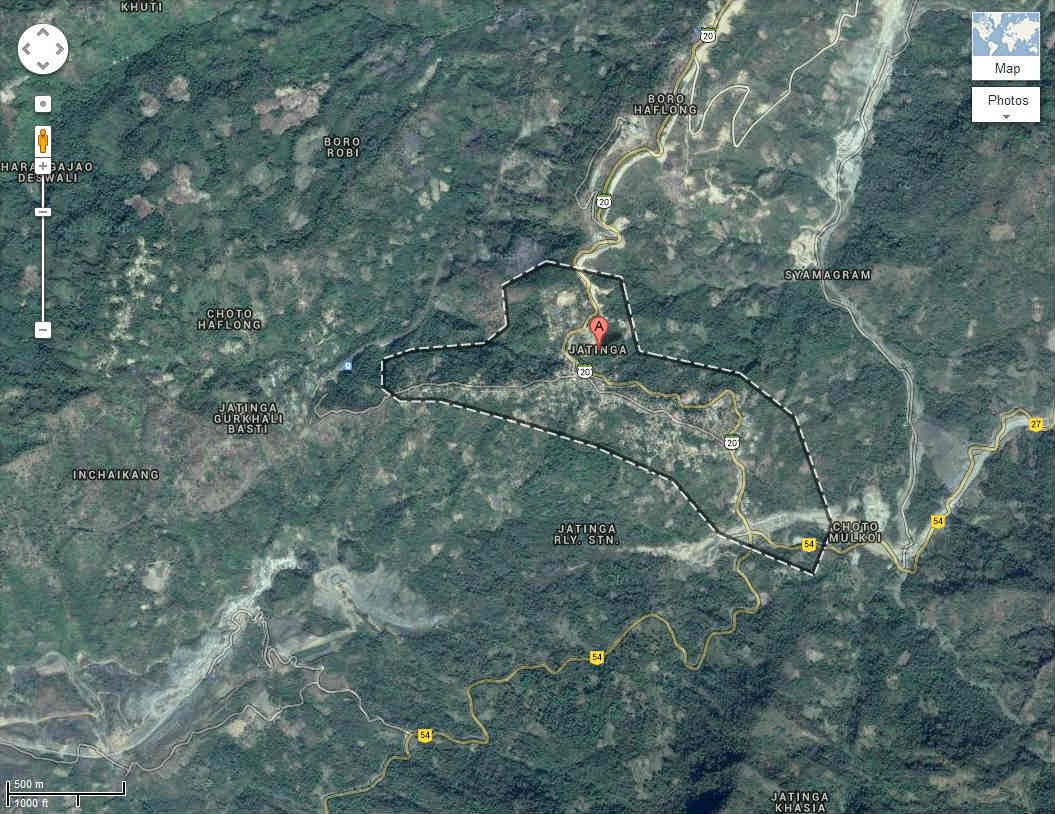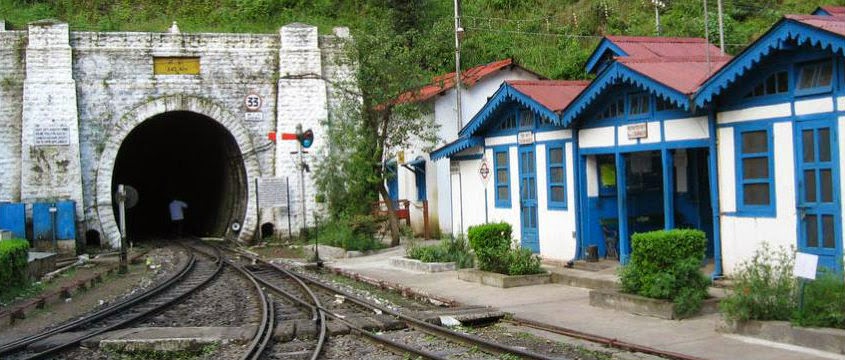Jatinga
is a mystic, beautiful, lush green village located on a ridge in the
North Cachar Hills of Dima Hasao District in Assam at the foothills
of the Borail range. It is located in the vicinity of Haflong town
which is the District Head Quarter of North Cachar Hills. It is a
popular tourist spot which is easily accessible by train, buses,
taxis and auto-rickshaws. Decorated with blue Vanda Orchids during
the flowering season, it is home to 2500 Dima Hasao population.
Jatinga is located about 330 km South of Guwahati – the commercial
capital of Assam. The natives earned their livelihood mostly from
forest products, specially cultivation of bamboo and export. Hunting
was a part of their life and the juveniles were trained to adopt
various hunting techniques.
The
mornings in Jatinga is illuminated by the spectacular sunlight
peaking through the Hempeopet Peak. The Hempeopet Peak is the second
highest peak in the mountainous terrain which gives tourists a
marvelous view. Jatinga is famous for its orange orchards, beautiful
orchid gardens, and its traditional tribal dances, and for the
mysterious suicidal tendencies in birds. In fact, Jatinga is also
called Death Valley for Birds due to the strange phenomenon of
avian mass suicides. There is a bird watchtower in Jatinga from which
one can witness the mysterious phenomenon, however prior permissions
from district forestry office in Haflong is necessary.
The
Zeme Naga tribes were the natives of Jatinga, which was ruled by the
Dimasa king. They were the first to witness the extraordinary
behavior of the birds in which hundreds of birds seem to be attracted
to their camp fires, descended from the sky and crashed to their
deaths by colliding into the bamboos, trees, or other man made
structures. Nowadays they also collide with buildings. This
phenomenon is unique and happens in the late evenings during the late
monsoon months of September and November. The tribals were frightened
with this rare phenomenon. They believed that it was wrath of the
Gods that the evil spirits and demons were falling to death from the
sky in the form of birds. Thus they abandoned the village and the
settlement was deserted.
Around
1905, some wanderers of the Jantia tribe found Jatinga and its
adjoining areas very suitable for beetle plantation and settled in
the abandoned village under the leadership of Lakhanbang Suchiang.
They came to know about the mysterious showering of birds when they
were searching for their stray cattle in the night with lighted
torches. The Jantia's considered the fatal attraction of the birds
towards the lighted bamboo torches as a “Gift of God”.
In
late 1950's British tea planter and ornithologist E.P.Gee and Salim
Ali visited this place to find out the cause of mysterious death of
migratory birds. The first record of this mysterious phenomenon is
found in the book Wild Life of India (1957) by E.P. Gee. Gee,
a naturalist, wrote that the suicides of birds only at the specific
spot is extraordinary. The phenomenon did not occur at the nearby
places even if they were illuminated just like Jatinga. He also
recorded the conditions required for this phenomenon - fog, cloud and
mist. The incident happens in the late monsoon months between
September and November in the late evenings mostly between 7:00 PM to
10:00 PM. It mostly happens in dark moonless nights with light rains
when the South Westerly winds are blowing. Gee brought this
mysterious phenomenon to the Global attention.
Jatinga
became a popular tourist destination by the 1980's. The mystery of
Jatinga attracts ornithologist from all over the world but the
phenomenon still needs to be investigated and understood. The most
likely cause of mass avian suicides could be disorientation of the
birds at high altitudes and high speed winds due to the widespread
fog, which is common at the end of the monsoons. Dr. Sudhir Sengupta
send by the Zoological Survey of India to investigate and
unscramble the mystery strongly believes that the magnetic
properties of subterranean water is altered by the atmospheric
conditions of this terrain. These changes though invisible, affect
the physiological rhythm of the local birds and they start behaving
abnormally towards the sources of light which leads to the mysterious
happening.
Dr
Anwaruddin Choudhury, one of Assam's best known ornithologist has
recorded a vivid description of this phenomenon in his book The
Birds of Assam. He has also compared similar incidents in
Malaysia, Philippines and Mizoram. He inferred that high velocity of
winds faze the shelter of the birds. The birds in distress, mostly
juvenile and local migrants fly towards the lights to find refuge. On
the way, they collide with bamboo poles, trees or such other sources
and are either killed or injured seriously which contributes to their
death.
This
extraordinary behavior is not confined to any specific species.
Records prove that 44 species of birds are attracted to the lights
including the Kingfishers (Oriental Dwarf Kingfisher, Ruddy
Kingfisher, etc), Tiger Bittern, Black Bittern, Cinnamon Bittern,
Little Egret, Indian Pond Heron, Chinese Pond Heron and Indian Pitta
and many other exotic species of birds. However, it has been
established that long distance migratory birds do not get attracted
towards the light sources. The victims are mostly nonmigratory birds
of the adjacent valleys and hill slopes. It has also been established
that the birds are attracted only to a distinct strip of land 1500
meters long and 200 meters wide. The birds mostly come in from the
North and attempts to place light sources on the Southern edge of the
Jatinga ridge has failed to attract them.
The
Statesman says that the birds are disoriented and fatally attracted
to the lighted bamboo torches lit by the villagers. Some of these
confused birds hover over the lights and are captured using bamboo
poles or catapults by the locals and are killed for food, while
others, bedazzled and disheveled land near the lights. Shocked by the
trauma, they do not attempt to fly away and fall easy prey to the
villagers. Various conservation groups and wildlife officials are
creating awareness among the illiterate villagers to prevent
motiveless killing of birds, which has reduced the deaths by about
40%.
Not
only the extraordinarily unusual behavior of the birds occur in
peculiar weather conditions, the events are also co-related to their
breeding periods. Heavy rains and flash floods submerge the natural
habitat of the water birds, and force them to take refuge in
neighboring areas. This seems to be common behavior since Jatinga
valley falls on the migratory route of locally migrating birds. Some
renowned ornithologists such as Dr. Salim Ali, Dr. Sudhir Sengupta,
A. Rauf, etc have done extensive research on this strange phenomenon,
but no hypothesis comprehensively explains the Jatinga mystery till
date. Research is still in progress to unravel the mystery of
Jatinga's unnatural phenomenon.
The Hindu on October 28, 2010 says, on a moonless night, when the mist and fog bearing South-Westerly winds blow over the Jatinga valley, different species of local migratory birds get attracted to strong light sources or “bird trap lights.” The phenomenon remains an unsolved mystery, with many theories doing the rounds.

























































